December 3, 2010
Air Date: December 3, 2010
FULL SHOW
SEGMENTS
Taking the Temperature of the Cancun Climate Talks
View the page for this story
In Cancun Mexico, co-hosts Steve Curwood and Bruce Gellerman eavesdrop on opinion makers, protesters and negotiators at the 16th Conference of Parties, the annual United Nations climate talks. After disappointment in Copenhagen last year, hopes are not high for a major breakthrough on control of greenhouse gases, but attendees do expect progress on forestry protection and targeting cash to help developing nations adapt to climate change. (05:30)
The Climate in 2010
View the page for this story
Delegates in Cancun have another year’s worth of climate science research to consider. Host Steve Curwood talks with Harvard Professor Daniel Schrag, a member of President Obama’s Council of Advisors on Science and Technology, about some of the most sobering studies of the past year and what they mean for the changing climate. (06:30)
In Kalimantan, Big Experiment, Big Hopes
/ Ingrid LobetView the page for this story
Climate and forestry experts are trying to figure out how to reduce carbon emissions from deforestation across the tropics. In Indonesia, on the giant island of Kalimantan (Borneo), The Nature Conservancy is trying to persuade timber companies and government officials to leave more trees standing and make money in the process. (18:00)
REDD Corruption
View the page for this story
The plan to pay developing nations to save their forests and the carbon in them is potentially worth billions of dollars under the UN scheme called REDD, Reducing Emissions from Deforestation and Degradation. Nearly $4 billion dollars is already on the table, and this cash has attracted both conservationists and criminals. Host Bruce Gellerman follows the money with Davyth Stewart, of the anti-corruption watchdog group, Global Witness. (05:40)
Negotiating Rights to Forests
/ Mitra TajView the page for this story
One problem with forest conservation under REDD is ensuring the rights and livelihoods of people that live in and depend on, tropical forest. While some countries are keen to write explicit protections for forest peoples, most are not, and its unclear what kind of guarantees might come out of negotiations in Cancun. Living on Earth’s Mitra Taj brings us the story. (07:45)
Cancun Voices
View the page for this story
We hear the voices, hopes and opinions of some of the many educators, environmentalists and officials in Cancun for the climate summit. (02:00)
Earth Ear
View the page for this story
(00:50)
Show Credits and Funders
Show Transcript
HOSTS: Bruce Gellerman, Steve Curwood
GUESTS: Daniel Schrag, Davyth Stewart
REPORTERS: Ingrid Lobet, Mitra Taj
GELLERMAN: From Public Radio International, this is Living on Earth. I’m Bruce Gellerman.
CURWOOD: And I’m Steve Curwood, ocean-side at the UN climate summit in Cancun Mexico, where delegates from more than 190 countries hope to find some means of agreement to fight global warming.
FIGUERES: Cancun will be successful, if parties compromise, if they make sure that in the process of getting what they want, they allow others to leave with what they need.
GELLERMAN: What the world needs now is an end to greenhouse gases. One scientist says we have plenty of time to prepare but we need to worry now.
SCHRAG: What matters to climate change is the total greenhouse gas emissions of the planet over the next 100 years. The bad news is that of course you have to ultimately drive greenhouse gas emissions to nothing to fix the problem.
CURWOOD: These stories and more from the UN climate summit in Cancun Mexico just ahead right here on Living on Earth. Que darse aqui!
GELLERMAN: Stay with us.
Taking the Temperature of the Cancun Climate Talks

COP16 UN and Mexican flags. (Photo: UNFCCC)
CURWOOD: From the UN Climate Summit in Cancun, Mexico, this is Living on Earth. I’m Steve Curwood.
GELLERMAN: And I’m Bruce Gellerman.
[OCEAN/WIND SOUNDS]
GELLERMAN: Waves crash along Cancun’s famed beaches. It’s a timeless backdrop to the climate negotiations where delegates from around the world are racing against time. This is the 16th year the United Nations has convened its Conference of Parties – the meeting designed to hammer out an agreement to deal with greenhouse gases and global warming.
[OCEAN/WIND SOUNDS]

Delegates at the COP16 Climate Change Conference. (Photo: UNFCCC)
CURWOOD: It’s the warm waters off the Yucatan Peninsula and Atlantic Ocean that help drive tropical storms. Five years ago Hurricane Wilma ripped through here. The monster storm, packing 175 mile-an-hour winds, did billions in damage and destroyed dozens of lives. This year’s Atlantic tropical storm season just ended. With twelve full-blown hurricanes, it’s the second highest on modern record.
[BAR MUSIC]
GELLERMAN: The music is hot as climate negotiators, members of NGOs, and journalists cool off after a long day of meetings gathering in a bar at the Moon Palace complex, the mega hotel where the climate talks are taking place.
[MUSIC]
CURWOOD: This year, climate delegates in Cancun need to demonstrate at least some progress after last year’s disastrous meeting in Copenhagen. At that summit what seemed to be a done deal --- a legally binding agreement to cut greenhouse gases -- came undone. Producing just a last minute, voluntary accord, brokered by the largest emitting nations. This year’s hurricane season may have been the calm before the storm.
[WASTEPICKERS DEMONSTRATION]
GELLERMAN: Despite intense security measures at the UN climate summit- navy ships patrolling off shore, federal police, and I.D. scrutiny- a group of Mexican workers—recyclers demanding an end to waste incinerators and landfills which emit greenhouse gases---were able to organize a demonstration inside the convention hotel.
[VOICE OF PROTEST LEADER]
CURWOOD: Less dramatic but no less emphatic was Marstella Jack who advises Micronesia in the climate talks.
JACK: What I see out of this conference, I think, is more talk on process, only process, but very little on content. What needs to be done is we need to have a fair ambitious and binding legal document that binds all big countries and small countries alike to take serious cuts in their emissions so we can save our planet.
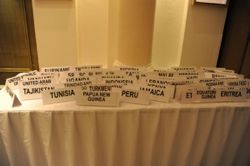
Countries from all over the world are represented at the conference. (Photo: UNFCCC)
CURWOOD: But the talks this year in Cancun are not expected to lead to an all-encompassing treaty. Christiana Figueres is the new executive secretary of the UN climate convention. She says what’s needed now after last year’s near disaster in Copenhagen is incremental progress.
FIGUERES: Cancun will be successful, if parties compromise, if they make sure that in the process of getting what they want, they allow others to leave with what they need.
CURWOOD: One positive sign: contentious rhetoric between the world’s two largest emitters of climate changing gases- the US and China - seems to have calmed, at least for the moment. China’s lead negotiator Su Wei, is director general of China’s climate department - and a veteran of the rough and tumble, and often troubled U.S.-China talks.
CURWOOD: What can come out of Cancun this year? What can happen here?
SU WEI: For Cancun, it’s not the end of the game. It’s only a part, a very important step in the long process. Of course, we would hope that since this is a global challenge, we need active politics and actions from all parties and we also hope the U.S. would honor its commitments in terms of reductions of its emissions of greenhouse gases.
GELLERMAN: Leading the United States delegation in Cancun the first week is Jonathan Pershing. Pershing says the United States will deliver on its pledge to reduce greenhouse gases by 17 percent by 2020.
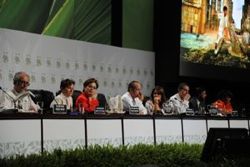
Leaders at the COP16 Climate Change Conference. (Photo: UNFCCC)
PERSHING: The president has also made and we continue to affirm the commitment that we made in Copenhagen last year. We are not moving away from that. Clearly, the next steps of implementing that are going to have to go through Congress, through regulation, through executive order. We’ll work on all of those tracks, all of those avenues at home to implement those programs and meet that commitment.
GELLERMAN: And, in what may be a significant breakthrough, the U.S. and China have reportedly agreed on a mechanism for measuring and verifying cuts in greenhouse gas emissions—something the U.S. had insisted on, and China had resisted. The bilateral deal may have helped save the multinational UN process.
GELLERMAN: Jennifer Morgan, is Director of the Climate and Energy program at World Resources Institute.

Community members gather in front of the Municipal Palace in Cancun, Mexico to pray in support of climate reform during the COP16 Climate Change Conference, on Tuesday Nov. 30, 2010. (Photo: Mark Malijan)
MORGAN: What happens here in some ways, the stakes are even higher than they were in Copenhagen because in some ways this is the second chance to get at least something moving forward, and if you can’t get it done on the second chance I don’t know if you get a third try.
CURWOOD: The Cancun climate talks now enter week two. Marstella Jack from Micronesia says with just a week left, the world is watching and waiting for action.
JACK: We’ve talked too much. Too much talk. The only action that we’re seeing is the sea level rising and the temperature heating up. This is about survival, it’s not carbon credits. It’s about survival.
GELLERMAN: Scientists now warn the risk of abrupt or irreversible climatic shift is growing – and the evidence keeps mounting.
Related link:
Visit the website for the UN Climate Change Conference
The Climate in 2010
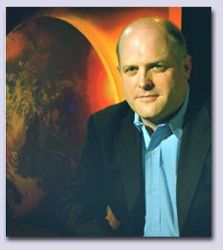
Harvard Professor and PCAST member, Daniel Schrag. (Photo: Daniel Schrag)
CURWOOD: To talk about the latest research, we turn now to Professor Daniel Schrag. He studies climate change at Harvard and directs the University’s Center for the Environment. He’s also a member of President Obama’s Council of Advisors on Science and Technology.
SCHRAG: You know there's a nice study that really put all this together that came out this year from the National Academy, and basically tripling atmospheric carbon dioxide levels, which we are likely to do in the next hundred to a hundred and fifty years, is really unprecedented, and there are all sorts of things that are going to have difficulties adapting to that, including human society. We are going to see devastation of species- something like 40 percent of the biodiversity is ultimately threatened today because it’s happening at so fast a rate that animals can’t migrate.
The other thing that came out of this National Academy report is the idea that fundamentally, what matters to climate change is the total greenhouse gas emissions of the planet over the next hundred years. Some of the climate policies that are focused on getting a ten or twenty percent reduction in the next ten years or twenty years- the bigger scale of things, actually that doesn’t matter so much. The bad news is of course, is that we have to ultimately drive greenhouse gas emissions to nothing to fix the problem.
CURWOOD: What about the permafrost? There was a study that was reported on, I think in the Journal of Science, on the melting of the permafrost that’s under the Arctic Ocean. What did you think of that study?
SCHRAG: Well, I think that study and many others similar to it, have pointed over the last many years to the amplifying factor of the permafrost melting which leads to lots of soil carbon both in the form of methane and the form of carbon dioxide being released into the atmosphere, and, providing a positive feedback to the burning of fossil fuels. Another way to think about this is that we’ve started the ball rolling from burning greenhouse gasses from fossil fuels and now the natural carbon system is going to take over. And the big question is: how fast does the methane and CO2 get released?
CURWOOD: So what other studies from this past year looked into feedback loops from natural systems that might amplify climate change?
SCHRAG: Well, one very important change that is continuing to occur is the melting of Arctic sea ice. And, the big story this year was that we didn’t set a new record in terms of the area of arctic sea ice, but if you actually look at the images of the arctic ice cap what you see is the area of very thick ice that is there perennially year after year, was almost half of what it had been in 2007. So, even that though there was a lot of ice cover, the actual permanent very thick ice had decreased significantly.
CURWOOD: Now, arctic ice is already in the ocean, so if it melts it doesn’t raise the sea level. What about the ice that is on the ground in places like Antarctica and Greenland?
SCHRAG: When we project sea level changes due to melting of ice, we tend to be extremely conservative. And so, for example, in the last IPCC report, what they did was they essentially assumed that the current rate of melting from Greenland would persist unchanged for the rest of the century, and that leads to only five centimeters of sea level rise from the melting of Greenland over the entire century.
Now, if you were to actually do a risk analysis, what you might do is perhaps assume that as the earth warmed, the ice would melt in proportion to the warming. If you make that simple assumption, you end up with the result that was published this year showing that perhaps the better estimate of sea level rise over the century is about one to two meters. So, three to six feet of sea level rise threatens every coastal city in the world. It’s a really big deal.
CURWOOD: Lets talk about drought. What have we learned in the past year about the prospect of drought as a function of climate change.
SCHRAG: Climate change is likely to bring more stress on both natural ecosystems and human society that will make dealing with droughts more and more difficult. For example, high altitude glaciers all over the world in the tropics are melting and exponentially increasing rains. And, since they’re the source for a lot of water in very important, strategic rivers all over the world, it means that when you have a drought because of meteorological conditions and you don’t have the backup of mountain-fed streams and rivers, it makes dealing with that drought all the more difficult.
CURWOOD: What about food? We’re going from six billion, well actually almost seven billion, to some nine billion in 2050 or so. How will climate impact our ability to feed ourselves?
SCHRAG: One of the interesting studies that has come out over the last few years suggests crops have a very complex relationship to not just rainfall, but actual temperature. For mild temperature increases, yields increase a little bit and then they cross a threshold and drop very dramatically. And, it’s a non-linear effect. A nice example is 2003 when Europe had that devastating heat wave and crop yields dropped by about 30 percent.

Harvard Professor and presidential advisor, Daniel Schrag. (Photo: Daniel Schrag)
That 2003 temperature is likely to be the average temperature a hundred years from now, for summer. And there’s a real question we have about plant physiology. Do we think that our ability to genetically engineer plants and selectively breed them- will we be able to find crops that produce high yields in a warmer climate and currently, there’s some research that suggests no. In fact, there are real physiological limits to plants because of the cycling of water through their stems that may fundamentally limit their productivity. We may see a big drop-off in food production.
CURWOOD: Now of course, you’re close to the White House, being on president Obama’s council of advisors on science and technology. How is the science that we have been discussing being presented in that setting and what feeling do you have that the President gets this?
SCHRAG: I have been in a meeting with the president where myself, and a number of other climate experts, briefed him directly, and it was very clear that the president does get it. He does understand how serious a problem this is. What he’s struggling with through a rather severe recession is, how to get the American public concerned about acting on climate change when they’re really worrying about their pocket books. And, that’s a very difficult problem. I don’t envy him. But, in terms of the science, in terms of the ultimate impact, he does understand it.
CURWOOD: Harvard Professor Dan Schrag, thank you so much.
SCHRAG: Thank you.
Related links:
- Learn more about Daniel Schrag
- Visit the President’s Council of Advisors on Science and Technology, PCAST’s, website
- Read climate reports put out by the National Academy of Sciences
[GROUP SINGING]
CURWOOD: Earlier this week, community members gathered in downtown Cancun to sing and pray in support of the UN climate summit.
[GROUP SINGING]
CURWOOD: Just ahead: a new scheme to save forests in Borneo. Keep listening to Living on Earth!
In Kalimantan, Big Experiment, Big Hopes
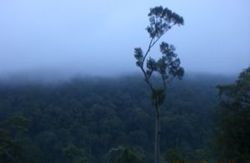
Intact forest in Berau District, East Kalimantan, Indonesia. (Photo: Ingrid Lobet)
GELLERMAN: REDD is also a major opportunity for conservationists who, for decades, have been trying to save the world's rain forests with little success. Under REDD, owners of forests would be paid to stop deforestation and keep the carbon in their trees.
The Nature Conservancy, perhaps the world's richest environmental organization, is already trying to get REDD going on the ground. It’s piloting a new approach in Borneo that could provide a template for the rest of Indonesia, and other countries as well. From eastern Borneo, Living On Earth's Ingrid Lobet reports.
[FOREST SOUNDS]
LOBET: Borneo. Indonesians call it Kalimantan, tropical forest iconic for its orangutans and its seeming endlessness. Coal mines and oil palm trees have flattened much of it but you can still see much of it, if you get up high enough. Nawa Irianto, with The Nature Conservancy, climbs the rungs of a fire tower.
IRIANTO: Kalimantan in the past was almost all like this. All of the island! But now only in the remote area we can find a few like this.
LOBET: Far below, a blur of brown-grey swings from tree to tree: monkeys.
IRIANTO: If brown or reddish, then it's the very rare one: Coo-coo-coo-coo!
LOBET: For years The Nature Conservancy tried to protect forests like this by buying them. But even a group with a billion dollar budget can only afford to buy a fraction of the forest. It’s a kind of triage: Conservancy biologists pore over satellite photos of disappearing forest. They know most can't be saved.
GRISCOM: I think, you know, the mentality that we, the conservation community, has had for a long time is sort of this painful process of prioritizing only the most critically endangered places.
LOBET: That's Bronson Griscom, a climate specialist with The Nature Conservancy. Once wildlife experts identify the very most endangered places, they try to protect them, for example, by making them into a park.
GRISCOM: And that is and remains a core strategy for The Nature Conservancy. But the world is not going to be one big park and we recognize that.
LOBET: Even when land is protected as national park, these parks often exist only on paper. Hungry people-- sometimes people who were displaced to create the parks in the first place-- farm and hunt inside the parks. Plantation companies build roads. Park rangers are few and underpaid.
Faced with this reality, The Nature Conservancy made a major break with the past. It began working with logging companies. Griscom says conservationists figured out a lot more animals survive in a timber concession than a forest converted to agriculture.
GRISCOM: The difference between a well-managed forest, logged using sustainable, well thought-out logging practices, that are designed to mimic natural disturbance, and a converted forest-- converted to some kind of plantation like oil palm-- is night and day. You are talking about a system that is maintaining almost all the biodiversity on the one hand as compared to a system that is maintaining very little of it
LOBET: The Nature Conservancy says: just come take a look.
[SOUND OF BOAT ENGINE SPUTTERING]
LOBET: So we travel to the end of the road and from there take a boat to Long Pay, an indigenous Dayak village.
[SOUND OF BOAT ENGINE AND WATER]
[LAKAN SPEAKING BAHASA INDONESIA]
LOBET: Jonas Lakan, a community leader, welcomes visitors into a traditional raised house. There’s a computer and maps of the village's traditional forests. Just a few years ago, Lakan recounts, this village was locked in a conflict with a well-known timber company that was clear-cutting.
[LAKAN SPEAKING BAHASA INDONESIA]
VOICEOVER: They logged our fruit trees. They even cut down the trees where we keep our bees.
LOBET: At a certain point the community got fed up with the company, and took away the keys to the bulldozers in protest. This cutting was contrary to the way they’d used the forest for hundreds of years.
[LAKAN SPEAKING BAHASA INDONESIA]
VOICEOVER: We held a protest and halted their production. We shut them down for three years.
LOBET: And for three full years, there was a standoff. Villagers and logging company didn’t talk. The Nature Conservancy got involved and people in Long Pay village began to organize and then negotiate with the timber company. They won the right to monitor tree-felling, and the company agreed to avoid cutting in certain areas.
[LAKAN SPEAKING BAHASA INDONESIA]
VOICEOVER: With TNC's assistance for mediation, we took the company back. Before the conflict, they cut down any kind of timber they wanted. Now we monitor their activities and they cannot take any tree under two feet in diameter. That's our way of conserving our forest. Because if we cut the small ones, we won’t have any trees left.
LOBET: So, resolution. And now several people have filled Jonas Lakan's living room, and they want to say why this forest is crucial for people who live here.
[MAN 1 SPEAKING BAHASA INDONESIA]
VOICEOVER: Everything we do, we take from the forest-- potatoes, vegetables, sago palm, rattan, you can gather them and even get enough to sell them.
[MAN 2 SPEAKING BAHASA INDONESIA]
VOICEOVER: To me the forest is like my car! Because I can get wood to make my boat from trees there. That’s why we care so much about our forest because it's like our transportation.
[MAN 3 SPEAKING BAHASA INDONESIA]
VOICEOVER: We're very careful about which trees we cut down. In fact we only cut down trees when we need to build our boats or our houses because we depend on the trees for our bees.
LOBET: At the mention of bees, several people have something to say.
[MAN 2 SPEAKING BAHASA INDONESIA]
VOICEOVER: Honey is our sugar, we mix it in water and drink it!
[LAKAN SPEAKING BAHASA INDONESIA]
VOICEOVER: It's so much easier for people who don't depend on the forest, they can just made decisions from afar. But for us who depend on it, if the forest is gone, what will we do?
LOBET: The villagers say that they're satisfied now with the timber company and the logging is more sustainable. The Nature Conservancy is trying to build a replicable model based on experiences like this one in Long Pai. They’re hoping to help build a model for all of Borneo. Or even the whole country. A model for keeping carbon out of the air, having communities benefit and protecting forest life at the same time.
To understand how, remember that as part of international climate talks, richer countries are pledging billions of dollars to poorer nations to help them develop cleanly, so they can leapfrog the dirty industry of the last century. Billions of dollars are being committed to preserving forests and the carbon within them to address climate change. These billions dwarf the interest the world has ever shown in rainforest protection until now. Again, The Nature Conservancy's Bronson Griscom.
GRISCOM: You are really talking about forests all over the place. And a level of financing that would generate national scale reductions of substantial decrease of the total deforestation across a country. Instead of dealing with, sort of this triage approach, prioritize a few spots and go after those, it’s really a much bigger scale.
LOBET: In fact The Nature Conservancy sees international climate finance as the last big opportunity for tropical conservation. But for carbon money to actually change the game, village-level efforts like the one in Long Pay must be scaled up to whole-country reductions in carbon emissions. In this area of Borneo that cannot be done without timber companies because they lease 40 percent of the land. So The Nature Conservancy is approaching them, one by one, to get them to improve their practices.
[CHAINSAW SOUND]
LOBET: It's an approach some environmental groups would find questionable.
[ENGINE KILLED, TREE FALLING SOUND]
LOBET: Red splinters spike up like daggers from a fresh tree stump.
[POWERFUL ENGINE]
LOBET: And swiftly, a 240 horsespower Caterpillar bulldozer drags the log, wracking the trees along the way. Finally, bulldozer and log arrive at the logging road, a muddy gash.
[SOUND OF TROPICAL INSECTS]
LOBET: Probably 80 feet across, 60 feet of road and ten feet of piles. When it rains, these roads pour silt into the streams. This is Belayan River Timber’s concession. It’s been clear- cutting. But the man in charge here, pak Totok, instead of seeming defensive, seems dismayed.
TOTOK: (Bahasa Indonesia translation) As a forester this makes me very sad. My conscience wants more sustainable foresting. In the future, we will keep learning to do things better.
LOBET: Do things better because Belayan River Timber and The Nature Conservancy are coming up with less destructive ways of logging.
[SOUNDS OF FOOTSTEPS]
LOBET: Using engines much smaller than bulldozers.
[ENGINE]
LOBET: Think of this as "no-gash" logging. Again, Bronson Griscom:
GRISCOM: With this system, you are sliding the logs along a very narrow skid road that requires no bulldozer. So, in the spirit of small is beautiful, we have a much smaller machine, it’s an engine. Do you know how much horsepower?
MAN 4: Twenty-two!
GRISCOM: Twenty-two horsepower. And what is the bulldozer?
[MEN TALKING IN BAHASA INDONESIA]
MAN 4: Three hundred. Two hundred to three hundred.
GRISCOM: So you have an engine that is ten times smaller, that is powering a big spool with a metal cable on it, and is just a very simple device.
LOBET: This cable-winch system uses one-tenth the fuel of logging with bulldozers. It's low-key enough that one guy is riding a log on its slow path uphill as if it’s a surfboard. Smaller engines mean fewer emissions. And fewer roads mean fewer cut trees. More carbon left in the forest. The Nature Conservancy is now working with eight of the 13 timber companies who own rights in this district.
[SOUNDS OF FOREST BIRDS/INSECTS]
LOBET: One of them recently won FSC or Forest Stewardship Council certification. Here again is the Conservancy's Nawa Irianto.
IRIANTO: In this plot we still can see, lets see: one, two, three, four, five, six, seven big trees. Means per hectare there are still seven big trees. It's still a healthy forest.
LOBET: Irianto is showing off a forest that still has large trees, even though it was logged. This selective logging is a middle path between clear-cutting and roping off the forest. If forests are harvested sustainably, they have the potential to sequester more carbon than if they’re simply left alone. The bulldozer logging path too is already growing over. That’s because the operator left small hills like giant speed bumps every 20 yards.
LOBET: You've built a berm here so that when it rains the water isn’t going to flow down the skid road.
IRIANTO: Yes, yes, and then the water run that way slowly, slowly and slowly and not heavy material down to the river system.
LOBET: Nawa Irianto is the one who does much of the work of persuading timber operators here to adopt these progressive practices. He’s perennially sunny and caffeine-charged and happy to explain.
[IRIANTO SPEAKING IN ENGLISH]
VOICEOVER: Usually there is resistance when they encounter an environmental organization. Because most non-profits are all about advocacy. But once they see we have an economic approach, and that there will be benefits to certification because they will get a premium price, and they can see nearby another company got certified, it's easier for us to convince the owners to move forward with certification.
LOBET: Certified lumber can fetch three and a half times the price of non-certified. As part of the certification, this company also has an inspector now: a tree guardian. His name is Bisam.
How about some of your guys working out here-- don’t they say "Hey can I take this one? This one's good?”
[BISAM SPEAKING BAHASA INDONESIA]
VOICEOVER: Yeah, they say that sometimes, but I forbid them from cutting the tree. I say, “No, you can't, because this is a protected tree. If you want to cut a tree, do it in your own village, on land owned by your community. You can do whatever you want there, but not here.”
LOBET: Bisam is part of the new face of Indonesia and many other developing countries well-educated young professionals who want sustainable development. And later in the timber camp barracks where he sleeps, Bisam says not just his education, but also things he has witnessed also make him yearn for forest protection.
[BISAM SPEAKING INDOENSIAN]
VOICEOVER: There are floods now, and there didn't used to be. My own home was destroyed by a flood. My house was destroyed because the deforestation means forest cannot absorb rainwater anymore.
LOBET: But if The Nature Conservancy hopes to lower forest carbon emissions across this whole district in Eastern Borneo, it must work not just with logging companies. It will also have to work closely with government at several levels. Government controls who gets to do what with land. Private ownership of land in Indonesia is practically unknown. Government slates different tracts for different uses. So The Nature Conservancy is making itself a presence right inside government offices.
NASHR: Working directly with them. So we go to their office, they come to our office, transferring knowledge, to show them like, the whole world is looking on them.
LOBET: That is Fakhrizal Nashr. He is The Nature Conservancy’s main government liaison in the region. Nashr says you wouldn't believe the impact it has on local officials when they get access to modern land use tools—like satellite maps and simulations.
NASHR: If you can imagine the bupati, the head, the number one person in the district. If he comes to his office room and he sees his area. ‘This is the forest that I got,’ he can play with that: ‘If I do this, if I change this, what will be the impact, what will be the economic gains?’ Then he knows what kind of decision he is going to make and how that is going to affect his own people.
LOBET: Nashr wants to show local officials that conservation forestry can pay.
NASHR: We needed to put more options to the forest. We need to put that it is not only palm oil conversion that is the most viable economically for this area, but there are more than that.
LOBET: What The Nature Conservancy hopes to do, is contract with logging companies and other industries across the district to lower their carbon emissions. In exchange, they'll be paid. The initial money to pay them will come from donors like France and Norway. Eventually the emissions reductions become a commodity that can be sold by a special Indonesian board set up for that purpose. This effort provides a crucial, first-of-its-kind link between a local project and a national government's promises to reduce emissions.
[SOUND OF THE FOREST]
LOBET: The Nature Conservancy’s efforts in Indonesia are well known and often cited by Indonesian officials. The whole project is still very much in the early stages, no contracts signed and no carbon credits sold. But the group’s hope is that it has found a way to protect forest and the amazingly diverse life within it. If enough of that life is left there, the warm wet forests here can regenerate, absorbing more of the carbon human beings send out. Nature then, helping to save us from ourselves. For Living on Earth, I’m Ingrid Lobet.
Related links:
- Ongoing Critical Look at Carbon Forestry
- Sekala Forest Climate Center Indonesia
- Tropical Forest Foundation
- Center for International Forestry Research
- Alternatives to Slash and Burn
- Questioning FSC Certification in Indonesia
- Forest Watch Indonesia (Global Forest Watch)
- Greenpeace Indonesia
- The Nature Conservancy East Kalimantan
CURWOOD: Just ahead – the promise of REDD may be big but all that cash is attracting the attention of organized crime and carbon cowboys. Stay tuned to Living on Earth.
REDD Corruption
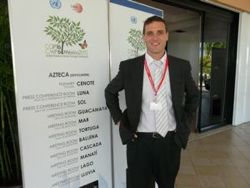
Davyth Stewart, Senior Forest Campaigner & legal counsel at Global Witness. (Photo: Bruce Gellerman)
CURWOOD: From the Cancun Climate Summit, this is Living on Earth. I’m Steve Curwood.
GELLERMAN: And I’m Bruce Gellerman. Asked why he robbed banks, infamous bank robber Willie Sutton reportedly quipped, “Because that’s where they keep the money.”
CURWOOD: Well, if Sutton was alive and thieving today you might find him in a forest - because that’s where trees store trillions of tons of carbon potentially worth billions of dollars. The UN mechanism known as REDD is designed to put a price on forest carbon so the owners have an incentive to keep trees standing instead of cutting them down.
Already there’s some four billion dollars for REDD projects on the table – and that could increase to 25 billion a year if climate negotiators can agree on how to implement and monitor REDD.
GELLERMAN: Davyth Stewart is a carbon crime buster - he investigates natural resources corruption with the London based watchdog group Global Witness, and is attending the UN climate summit.
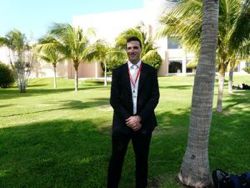
Davyth Stewart, Senior Forest Campaigner & legal counsel at Global Witness. (Photo: Bruce Gellerman)
STEWART: It’s the kind of area you would think of investing in if you were an organized criminal. There’s certainly organized crime looking at REDD as a potential market to become engaged in. There’s going to be a lot of money coming in from the climate change process. And, a lot of the places in which the money is moving into countries with serious corruption risks, with poor countries with poor law enforcement, poor regulations. It’s easy to move in and move money around and manipulate the system to take advantage.
GELLERMAN: So, if you were a nefarious person, and wanted to take advantage of the proposed REDD scheme, the scheme to protect trees and keep their carbon stored and locked in there—how might you do that?
STEWART: I’d be particularly interested in countries that don’t have clear land tenure, where ownership of the land is unclear, in which it’s very easy to manipulate land ownership. And so it’s who owns the land is going to own the resource. And we now have carbon as a commodity, which people are looking at and is now far more valuable.
GELLERMAN: How much money are we talking about?
STEWART: We’re talking 15-20 billion dollars a year within the next five to ten years.
GELLERMAN: So, it’s really where the money is!
STEWART: There’s a lot of money in forest protection. It’s considered one of the more viable climate change solutions, so there’s a lot of investment going into it. There’s a lot of money being put out by more donor countries, by large multi-lateral institutions, all looking at ways of investing in forest protection because forests store a lot of carbon so they are an essential key plank to any climate change solution.
GELLERMAN: You know, there have already been cases where people have tried to corrupt the system, and they’ve succeeded in some cases.
STEWART: There’s reports of carbon cowboys moving into Papua New Guinea trying to manipulate the system to take ownership of land, or have local landowners sign over their carbon rights and in some cases through the threats of violence.
There are reports in Papua New Guinea of the Office of Climate Change issuing carbon credits, even though there was no legislation in place. There’s an investigation into some British-based companies that are looking at entering into agreements with governments over ownership of the carbon or the ability to trade the carbon on international markets. And, there are reports of bribes being paid—of not fair prices of carbon being paid, and people taking advantage of weak government systems.
GELLERMAN: So are there international laws against this? Do we have a system for monitoring it and for punishing people?
STEWART: At this stage we don’t. It’s mostly done on the voluntary carbon market, so all of this activity that’s going on now is people getting in early in preparation for the big money that’s coming.
So, there isn’t any mechanism that can monitor it, that can ensure that it’s being done according to any international standards, because there are no international standards at this point. And, it’s an issue that we in Global Witness are advocating further involvement of law enforcement agencies at the beginning in helping to design the system so that there aren’t loopholes, that the system is implemented in a way that it can be easily enforced, rather than trying to fix it up afterwards, too late.
GELLERMAN: So, is it possible that this conference will come up with a mechanism, a REDD mechanism to save the carbon in trees, but then when nefarious types, people with less than noble motives, move in, that nothing will happen. There will be no stored carbon and the money will just disappear?
STEWART: It’s quite possible. There’s a genuine push by many to get a good deal here at these climate change talks, in which there will be a strong regime to protect the forests. But, there are also many other vested interests involved in this process looking for a deal on forest protection that isn’t necessarily in the interest of the environment, but is in their own vested interests.
So there’s a push by the logging industry to protect forests for the benefit of logging, not for the benefit of the climate. There’s a push to provide subsidies to the plantation industry.
If there’s a lack of safeguard in the agreement that we come up with, it may well end up subsidizing palm oil plantations. And, particularly scary, is that it may provide incentive to actually chop down natural forests and replace it with palm oil plantations. It’s the lack of these sort of safeguards that undermine the environmental integrity of this sort of agreement.
GELLERMAN: So, how close are they to building in the safeguards that you’d like to see?
STEWART: We have some relatively strong language around the safeguards, but in terms of actually implementation there’s a lot of weak language. And that’s the really important issue that we have to get right at these climate change talks.
GELLERMAN: Well Davyth thank you very, very much, I really appreciate it.
STEWART: You’re welcome, thank you.
GELLERMAN: Davyth Stewart is with the anti-corruption monitoring group, Global Witness.
Related link:
Visit Global Witness’ website
[MUSIC: Los Lobos “Jupiter Or The Moon” from Tin Can Trust (Shout Factory 2010)]
Negotiating Rights to Forests
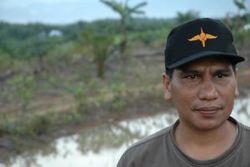
Saruha says he will keep fighting the pulpwood company until it recognizes villagers' right to the land (in Indonesia it's common to not have a last name). (Photo: Mitra Taj)
CURWOOD: Along with the threat of corruption, there is another risk of the forest carbon protection scheme called REDD—the displacement of peoples who have traditionally lived there.
More than 350 million people around the world live in or near forests. And while there are now successful pilot efforts to mediate the tensions between various commercial interests and forest dwellers, climate negotiators have yet to agree on language to protect forestry community rights. Living on Earth’s Mitra Taj has our story, and she begins her report on the island of Sumatra in Indonesia.
TAJ: Saruha is a community leader of the village of Rokan Hulu on the island of Sumatra. On a cloudy day he stands on a hill on the outskirts of the village and waves his hand toward a vast expanse of trees.
[SARUHA SPEAKING INDONESIAN]
VOICEOVER: (In Indonesian) In the past, all of this land belonged to the people.
TAJ: He says the land used to be everything for the villagers—a source of food, a source of building materials, where future farm plots would support generations to come. But in the ‘90’s when the Forestry Ministry wrote the land into a concession for a pulpwood company, it became the stage for a tragic conflict.
[SARUHA SPEAKING INDONESIAN]

Saruha says he will keep fighting the pulpwood company until they recognize their right to the land. (Photo: Mitra Taj)
TAJ: Saruha says the deal denied villagers access to even a small slice of the forest. They protested by cutting down pulpwood trees. The company, PT SSL, a supplier of the paper giant APRIL, had the police arrest the protesters…Tensions rose, and during a meeting with company officials, chaos broke out. Villagers threw rocks, and Saruha says the company’s security guards started beating villagers with sticks covered in nails.
[SARUHA SPEAKING INDONESIAN]
VOICEOVER: Everyone was running in every direction to save their lives. I ran to a pick-up truck, 30 people got on. We took off and the company’s employees came chasing after us in another car. We got away, and a few days we found two dead bodies in a nearby pond.
TAJ: He says another bruised body turned up later in the forest. Three village women became widows, including Rosita, the young mother of three boys.
[ROSITA SIGHING, SPEAKING INDONESIAN]
VOICEOVER: I don’t know exactly why my husband died but I know my husband died here. It’s very sad and very hard because he was the leader of this family; he struggled for the land because the land feeds his children.
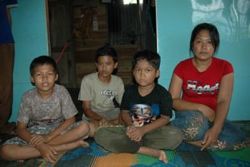
Since her husband's violent death, Rosita has cares for her three boys on her own. (Photo: Mitra Taj)
TAJ: The head of PT SSL, Pohan says his employees didn’t kill anyone and didn’t do anything wrong, but that he gave Rosita and the other widows the equivalent of about $2,000 out of compassion. The local police chief Ansori claims Rosita’s husband and his friend fell into the pond and drowned because they couldn’t swim; and the third man died from exhaustion as he ran through the forest.
But Nurkholis, an investigator with Indonesia’s independent Human Rights Commission, says the incident, from beginning to end, violated basic human rights. The central government didn’t take the villagers’ land claims seriously and didn’t mediate a solution, the police didn’t do their job—the bodies were marked with signs of torture, but autopsies were never conducted. And the case, he says, is far too common in Indonesia.
[NURKHOLIS SPEAKING INDONESIAN]
VOICEOVER: I’ve work at the National Commission for Human Rights for more than two years and I’ve visited every single province in Indonesia. And there have always been conflicts in the forests of every single province.
TAJ: In Indonesia, 65 million people live off forests—most of them, like the villagers of Rokan Hulu, have no official rights to the land they consider theirs. In the eyes of the Forestry Ministry, they’re squatters occupying a national resource. And Indonesia is not alone—governments own about 75 percent of the world’s forests, less than ten percent legally belong to communities.
[SOUNDS OF CANCUN CLIMATE CONFERENCE]
TAJ: At climate talks in Cancun, Mexico, with the eyes of the world now on REDD or forest protection as a way to fight climate change, the stakes have been raised, and many worry a final REDD agreement won’t do enough to protect people.
RIGGS: I think REDD without rights guarantees is potentially a disaster.
TAJ: Peter Riggs works for the Ford Foundation. He says the language that will determine which course REDD takes is being written now in Cancun and could affect generations to come.
RIGGS: If REDD proceeds in a top-down way where governments reassert control over forested areas, and in many places the only way they can reassert that control is through the militarization of the forest, basically sending in troops to kick people out of places where they’ve traditionally lived in order to secure the carbon benefits of REDD, that is a social disaster.
But if REDD were to move in such a way that community rights were guaranteed and in fact led to a reduction in forest conflict, then REDD could be a very positive thing.
TAJ: Right now the current REDD negotiating text mentions support for the rights of indigenous and local communities, but Tom Goldtooth, the executive director of the Indigenous Environmental Network and a member Dine’ and Dakota tribes, wants specifics.

Some wonder if the delegates at the COP16 Climate Change Conference will create a REDD agreement that protects indigenous people. (Photo: UNFCCC)
GOLDTOOTH: We’re not just asking for the right to participation, we’re asking for the right to be involved in the decision-making processes. We’re not just a stakeholder—in the North, you know, these were our lands. We’re the original peoples of the Americas.
TAJ: Goldtooth says he doesn’t want to see his indigenous brothers and sisters in tropical countries lose their land and way of life, and key to securing their rights under REDD are four words: free, prior, informed consent. Peter Riggs says that provision is controversial in Cancun.
RIGGS: Because it essentially would give communities veto power over projects in their area, and not all governments are willing to give communities that kind power.
TAJ: Bolivia is one of the few that are willing. Chief negotiator Pablo Solon not only wants to put in more language on community rights on REDD, he wants to take out market incentives—no trading carbon credits, and no allowing polluters to offset emissions by paying others to protect forests.
SOLON: We think that it’s crucial to protect and preserve forests and we think we should protect forests through public funds. What we don’t agree is that we will use a very good and very noble cause in order to promote something that only will worsen things, and that is the market mechanism that will commodify, at the end, the forest and nature. That is what we don’t support. We have said it very clearly.
TAJ: Because the UN climate negotiations require all countries to be on board before agreement can be made, Bolivia could prevent a REDD agreement from being finalized…Tom Goldtooth says stopping an agreement that doesn’t include stronger guarantees for forest communities would be a good thing.
GOLDTOOTH: Right now a lot of the movers and supporters of REDD here are saying, well trust the process, there will be safeguards we just need to move forward. We can’t do that because history has shown that often in these developments and under the economic paradigms that we have right now our local communities are very often they end up dead, you know…
TAJ: Weak land rights for forest peoples in some tropical countries aren’t just a concern for negotiators in Cancun right now; they could make it tough to get REDD going, even if an agreement comes through next week.
RIGGS: Everybody assumes the private sector will want to rush into REDD once its set up as a global mechanism. My conversations with private investors say that they are extremely wary about REDD, and the reason that they’re wary about it is because they don’t want to get involved in a situation where there are land conflicts. And they have not only financial risk, but real reputation risks associated with that.
TAJ: For Living on Earth, I’m Mitra Taj in Cancun, Mexico.
Related links:
- Click here for more of LOE's coverage of REDD.
- Documents suggest Indonesia's special forces have systematically murdered and abduction civilians in West Papua.
[MUSIC: Leo Kottke “Three/Quarter North” from One Guitar, No Vocals (BMG Entertainment 1999)]
Cancun Voices

Inside the COP16 Climate Change Conference center. (Photo: Bruce Gellerman)
GELLERMAN: Government representatives, environmentalists and educators are among the 13,000 people from around the globe who are attending the Cancun climate summit. We asked a few of them what needs to be accomplished at the meeting.
MCCRAE: My name is Christine McCrae and I’m from Canberra in Australia. I’m with the World Association of Girl Guides and Girl Scouts. I would be very happy, if, at the end of COP16 there was a decision taken by all of the countries present here, that education on climate change should be continued.
And that there is increased gender balance on education of climate change, so girls and boys get the same access to education. Because educating women on climate change is really important. They’re the mothers, they’re the sisters in this world and they educate their families and their communities, particularly in developing countries.
MISSION: I’m Charles Meshack. I’m from Tanzania Forest Conservation Group. I would say climate change is happening and it’s real and we have to do something.
I won’t expect countries to have common agreement because of the different histories across the globe. So at the end of the day actually, countries have to think how are they going to address climate change at a national level, at a local level.
Earth Ear
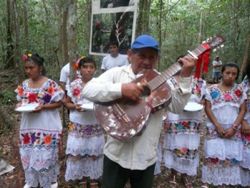
A Mayan farmer plays a traditional song.
CURWOOD: On the next Living on Earth, we travel deep into the jungle of the Yucatan peninsula where Mayan forest people work the land…and harvest chichle…gum from 500 year-old trees.
WOMAN: The way of the extract this gum is, it represents their traditions and their culture, a part of supporting their families.
CURWOOD: Saving forests and an ancient culture next time on Living on Earth.

Mayan farmer plays a song.
[STRUMMING]
CURWOOD: We leave you this week in the Yucatan Peninsula at an ejido or collective farm.
MAN: This song is for you. It’s a Mayan song.
[GUITAR SOUNDS]
CURWOOD: San Antonio Tuk is a community of Mayan farmers…sunlight filters through the dense tropical forest as a local musician entertains visiting journalists covering the UN Climate Summit five hours and a world away in Cancun.
[MAN SINGING AND PLAYING MUSIC]
CURWOOD: Living on Earth is produced by the World Media Foundation. Our crew includes Bobby Bascomb, Eileen Bolinsky, Ingrid Lobet, Helen Palmer, Jessica Ilyse Smith, Ike Sriskandarajah, Mitra Taj, and Jeff Young, with help from Sarah Calkins, Sammy Sousa, and Emily Guerin.
GELLERMAN: Our interns are Nora Doyle-Burr and Honah Liles. Jeff Turton is our technical director. Alison Lirish Dean composed our themes. You can find us anytime at L-O-E dot org, and while you’re online, check out our sister program, Planet Harmony.
CURWOOD: Planet Harmony welcomes all and pays special attention to stories affecting communities of color. Log on and join the discussion at My Planet Harmony dot com. And don’t forget to check out our Facebook page, PRI’s Living on Earth. I’m Steve Curwood.
GELLERMAN: And, I’m Bruce Gellerman. Thanks for listening.
CURWOOD & GELLERMAN: ¡Adios! ¡Desde Cancún!
ANNOUNCER: Funding for Living On Earth comes from the National Science Foundation supporting coverage of emerging science. And Stonyfield farm, organic yogurt and smoothies. Stonyfield pays its farmers not to use artificial growth hormones on their cows. Details at Stonyfield dot com. Support also comes from you, our listeners. The Ford Foundation, The Town Creek Foundation, The Oak Foundation—supporting coverage of climate change and marine issues. The Bill and Melinda Gates foundation, dedicated to the idea that all people deserve the chance at a healthy and productive life. Information at Gates foundation dot org. And Pax World Mutual Funds, integrating environmental, social, and governance factors into investment analysis and decision making. On the web at Pax world dot com. Pax World for tomorrow.
ANNOUNCER 2: PRI – Public Radio International
Living on Earth wants to hear from you!
Living on Earth
62 Calef Highway, Suite 212
Lee, NH 03861
Telephone: 617-287-4121
E-mail: comments@loe.org
Newsletter [Click here]
Donate to Living on Earth!
Living on Earth is an independent media program and relies entirely on contributions from listeners and institutions supporting public service. Please donate now to preserve an independent environmental voice.
NewsletterLiving on Earth offers a weekly delivery of the show's rundown to your mailbox. Sign up for our newsletter today!
 Sailors For The Sea: Be the change you want to sea.
Sailors For The Sea: Be the change you want to sea.
 The Grantham Foundation for the Protection of the Environment: Committed to protecting and improving the health of the global environment.
The Grantham Foundation for the Protection of the Environment: Committed to protecting and improving the health of the global environment.
 Contribute to Living on Earth and receive, as our gift to you, an archival print of one of Mark Seth Lender's extraordinary wildlife photographs. Follow the link to see Mark's current collection of photographs.
Contribute to Living on Earth and receive, as our gift to you, an archival print of one of Mark Seth Lender's extraordinary wildlife photographs. Follow the link to see Mark's current collection of photographs.
 Buy a signed copy of Mark Seth Lender's book Smeagull the Seagull & support Living on Earth
Buy a signed copy of Mark Seth Lender's book Smeagull the Seagull & support Living on Earth

